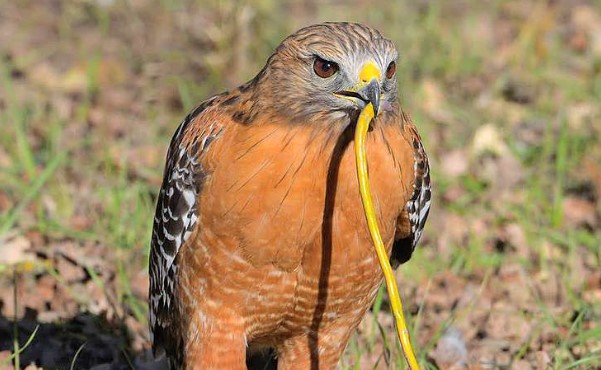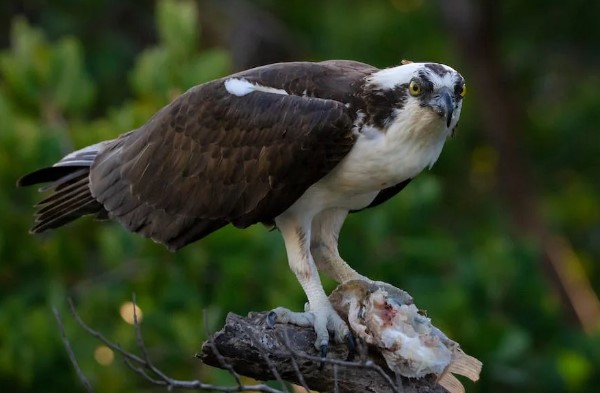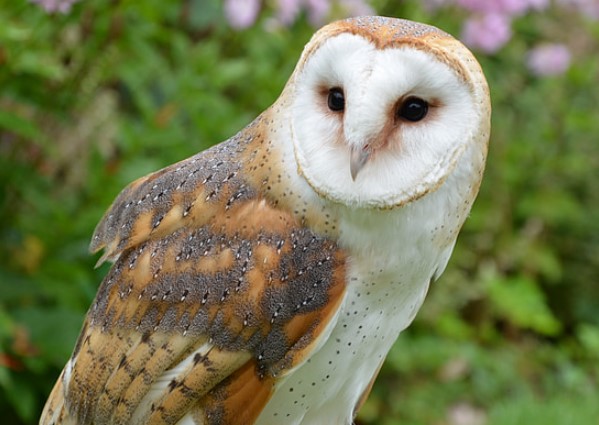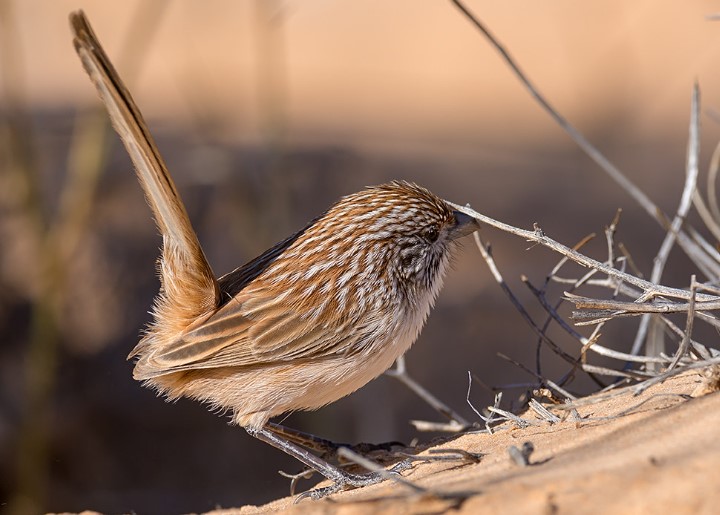American birds of prey have keen eyesight, sharp talons, and powerful beaks, which they use to capture their prey. The Birds of prey, also known as raptors, are a group of birds that hunt and feed on other animals, primarily small mammals, reptiles, and insects. Examples of birds of prey include eagles, hawks, owls, and falcons. There are many species of birds of prey found in North America, including the following ten:

1. Bald Eagle:
They are known for their distinctive white head and tail feathers, yellow beak and feet, and dark brown bodies. Bald Eagles are found near large bodies of water, such as oceans, lakes, and rivers, and feed on fish, small mammals, and other birds. They are opportunistic hunters and will also scavenge for food.
Bald Eagles mate for life and build large nests in trees, which they reuse year after year. They are territorial and will defend their nests from other eagles and intruders. In the 20th century, the Bald Eagle population declined due to habitat loss, illegal hunting, and the effects of DDT on reproduction. However, with the ban on DDT and increased conservation efforts, the Bald Eagle population has made a remarkable recovery and was removed from the Endangered Species List in 2007. The Bald Eagle is an important symbol of freedom and American ideals and continues to be an iconic species that represents the strength and resilience of the natural world.

2. Golden Eagle:
The Golden Eagle (Aquila chrysaetos) is a large bird of prey that is native to the Western Hemisphere, with a range that extends from North America to South America. They are known for their striking golden-brown plumage, distinctive dark wingtips, and powerful build.
Golden Eagles are found in a variety of habitats, including deserts, mountains, and forests. They are opportunistic hunters and feed on a variety of prey, including small mammals, birds, and reptiles. They are also known to scavenge for food.
Golden Eagles are solitary birds and mate for life. They build large nests, usually on cliffs or in tall trees, and will reuse the same nest for several years. They are territorial and will defend their nests from other birds and intruders. Golden Eagles are highly regarded for their hunting skills and have been used for falconry for thousands of years. They are also valued for their beauty and are considered a symbol of strength and freedom.
Despite their wide range and popularity, Golden Eagles face threats from habitat loss, illegal hunting, and collision with man-made structures such as power lines and wind turbines. Conservation efforts, including habitat protection and management, are needed to ensure the continued survival of this important species.

3. Peregrine Falcon:
The Peregrine Falcon (Falco peregrinus) is a bird of prey known for its speed and agility. They are found throughout the world and are distributed on every continent except Antarctica. Peregrine Falcons are found in a variety of habitats, including coastal areas, mountains, and urban environments. They feed on birds, bats, and small mammals, and are known for their incredible speed and aerial prowess. They are capable of diving at speeds of over 240 miles per hour to catch their prey. Peregrine Falcons mate for life and build their nests on cliffs or tall buildings. They are territorial and will defend their nests from other birds and intruders.
In the mid-20th century, the Peregrine Falcon population declined dramatically due to the widespread use of DDT, which caused thinning of their eggshells and reduced reproductive success. However, with the ban on DDT and a successful captive breeding and reintroduction program, the Peregrine Falcon population has made a remarkable recovery. The Peregrine Falcon is considered a symbol of resilience and the power of conservation and continues to be an important species in the world of birds of prey.

4. Osprey:
The Osprey (Pandion haliaetus) is a bird of prey found near large bodies of water, such as oceans, lakes, and rivers, throughout the world. They are known for their distinctive appearance, with a white head and underbelly, dark brown back and wings, and a hooked beak.
Ospreys feed almost exclusively on fish and are specially adapted for hunting in the water. They have reversible outer toes that allow them to grip their prey with two toes in front and two toes in back, and barbed pads on the soles of their feet for added grip. Ospreys mate for life and build large nests near the water’s edge, usually on top of poles, trees, or rocks. They are territorial and will defend their nests from other birds and intruders.
In the 20th century, the Osprey population declined due to habitat loss, pollution, and the effects of DDT on reproduction. However, with increased conservation efforts and the ban on DDT, the Osprey population has made a remarkable recovery. The Osprey is considered a symbol of the health of aquatic ecosystems and continues to be an important species in the world of birds of prey.

5. Red-tailed Hawk:
The Red-tailed Hawk (Buteo jamaicensis) is a bird of prey found throughout North America, from Alaska to Panama. They are known for their distinctive red tail feathers, which give them their name, and their broad, rounded wings.
Red-tailed Hawks are found in a variety of habitats, including forests, deserts, and grasslands. They feed on a variety of prey, including small mammals, birds, reptiles, and insects. They are also known to scavenge for food.
Red-tailed Hawks mate for life and build large nests in trees, on cliffs, or on man-made structures. They are territorial and will defend their nests from other birds and intruders.
Red-tailed Hawks are highly adaptable and have adjusted well to human development, making them a common sight in urban and suburban areas. They are also valued for their beauty and are considered a symbol of the American West.
Despite their widespread distribution and adaptability, Red-tailed Hawks face threats from habitat loss, collisions with man-made structures, and illegal shooting. Conservation efforts, including habitat protection and management, are needed to ensure the continued survival of this important species.

6. Barn Owl:
The Barn Owl (Tyto alba) is a bird of prey found throughout the world, with a range that extends from the Arctic Circle to the tropics. They are known for their distinctive heart-shaped face, white underbelly, and reddish-brown upper plumage. Barn Owls are nocturnal hunters and feed primarily on small mammals, such as mice and voles. They have excellent hearing, which allows them to locate their prey in the dark, and soft, silent flight feathers that allow them to hunt quietly.
Barn Owls mate for life and build their nests in cavities, such as tree hollows or old buildings. They are not territorial and will often use several different roosting sites in a given area. Barn Owls play an important role in controlling rodent populations and are highly valued for their ecological services. However, they face threats from habitat loss, pesticide use, and collision with man-made structures. Conservation efforts, including habitat protection and management, are needed to ensure the continued survival of this important species.

7. American Kestrel:
The American Kestrel (Falco sparverius) is a small bird of prey found throughout the Americas, from Alaska to Tierra del Fuego. They are the smallest and most widespread species of falcon in North America.
American Kestrels are found in a variety of habitats, including deserts, grasslands, and urban areas. They feed on small mammals, birds, insects, and reptiles. They are known for their aerial acrobatics and their ability to hover in place while searching for prey.
American Kestrels mate for life and build their nests in cavities, such as tree hollows or man-made structures. They are not territorial and will often use several different roosting sites in a given area.
Despite their widespread distribution and adaptability, American Kestrel populations have declined in recent decades due to habitat loss, pesticide use, and other factors. Conservation efforts, including habitat protection and management, are needed to ensure the continued survival of this important species.

8. Northern Harrier:
The Northern Harrier (Circus hudsonius), also known as the Marsh Hawk, is a bird of prey found throughout the Northern Hemisphere. They are known for their distinctive appearance, with a long, narrow tail, a white rump, and a round head with a pale face.
Northern Harriers are found in a variety of habitats, including marshes, grasslands, and tundra. They feed primarily on small mammals, such as voles and mice, and hunt by flying low over the ground and using their sharp talons to grab their prey. Northern Harriers mate for life and build their nests on the ground, often in tall grass or marsh vegetation. They are not territorial and will often use several different roosting sites in a given area.
Despite their widespread distribution and adaptability, Northern Harrier populations have declined in recent decades due to habitat loss, pesticide use, and other factors. Conservation efforts, including habitat protection and management, are needed to ensure the continued survival of this important species.

9. Cooper’s Hawk:
The Cooper’s Hawk (Accipiter cooperii) is a bird of prey found throughout North America, from Alaska to Panama. They are known for their distinctive appearance, with a rounded tail and short, broad wings.
Cooper’s Hawks are found in a variety of habitats, including forests, suburbs, and urban areas. They feed primarily on birds and are known for their stealth and speed as they pursue their prey through the trees. Cooper’s Hawks mate for life and build their nests in trees, often near the trunk or in dense vegetation. They are territorial and will defend their nests from other birds and intruders.
Despite their widespread distribution and adaptability, Cooper’s Hawk populations have declined in recent decades due to habitat loss, pesticide use, and other factors. Conservation efforts, including habitat protection and management, are needed to ensure the continued survival of this important species.

10. Red-shouldered Hawk:
The Red-shouldered Hawk (Buteo lineatus) is a bird of prey found throughout the eastern half of North America, from southern Canada to Florida. They are known for their distinctive appearance, with a rusty red patch on their underwings and a distinctive, raspy call.
Red-shouldered Hawks are found in a variety of habitats, including forests, swamps, and urban areas. They feed primarily on small mammals, reptiles, and amphibians, and hunt by perching on a high branch and diving down to grab their prey. Red-shouldered Hawks mate for life and build their nests in trees, often near the trunk or in dense vegetation. They are territorial and will defend their nests from other birds and intruders.
Despite their widespread distribution and adaptability, Red-shouldered Hawk populations have declined in recent decades due to habitat loss, pesticide use, and other factors. Conservation efforts, including habitat protection and management, are needed to ensure the continued survival of this important species.







